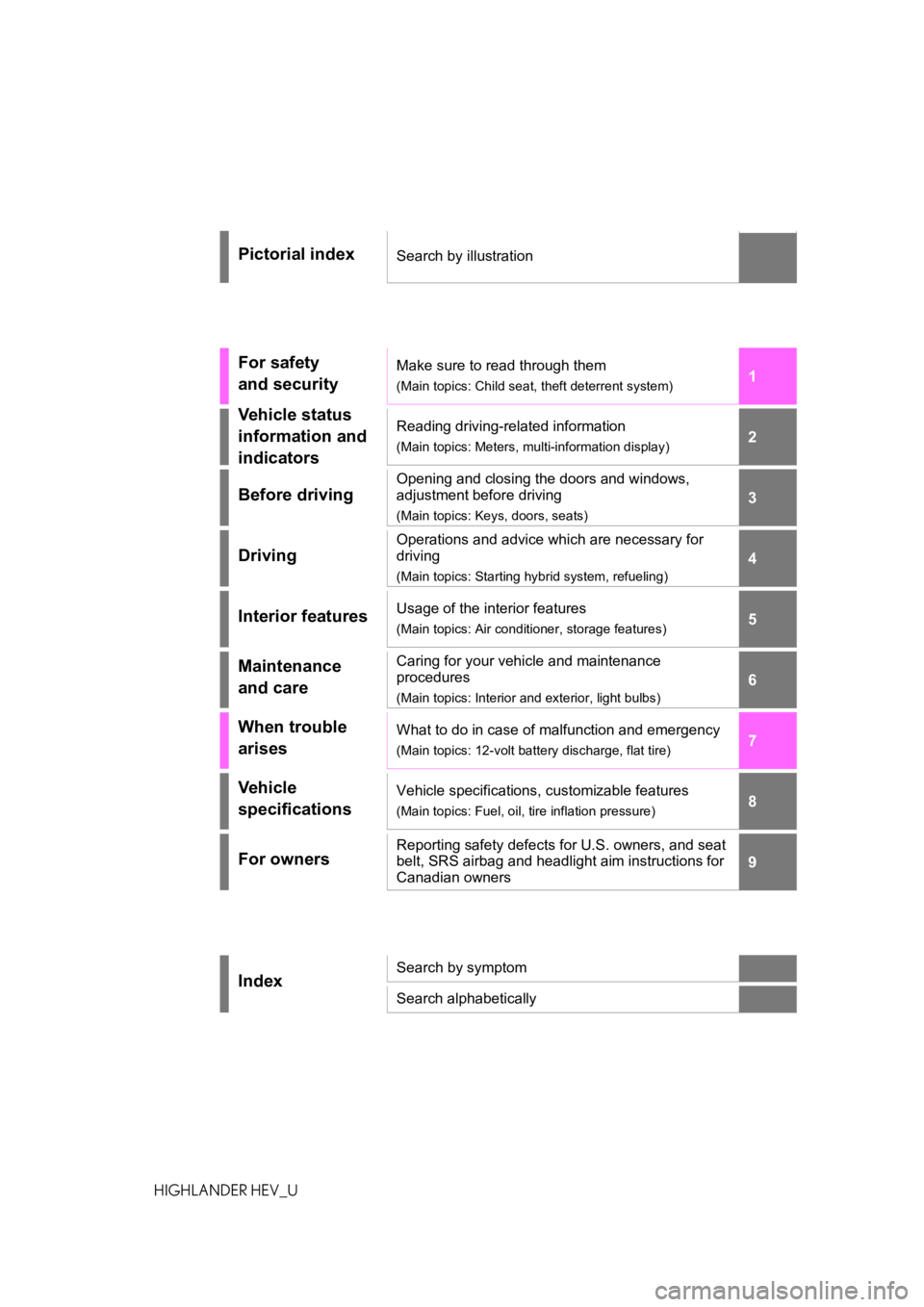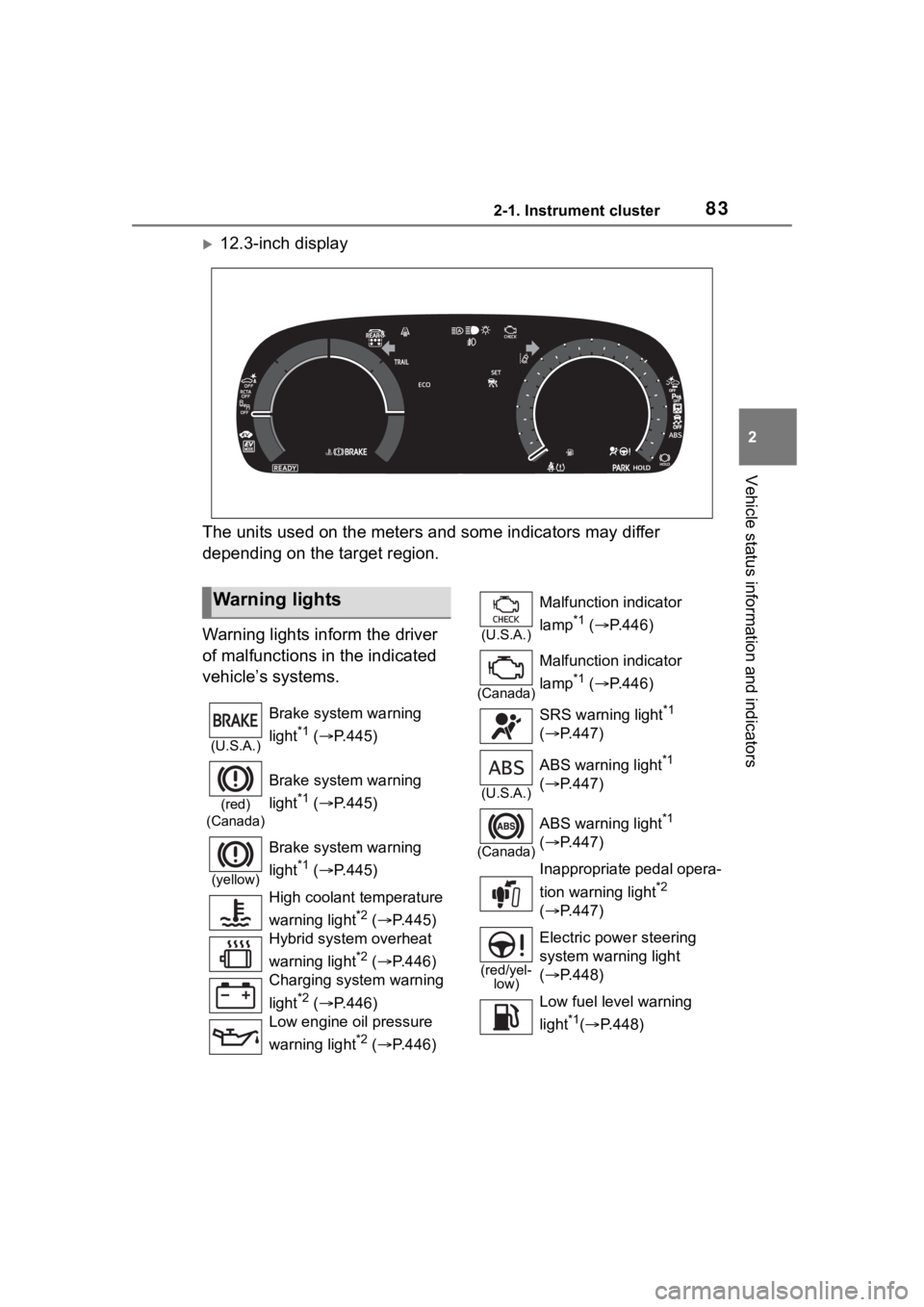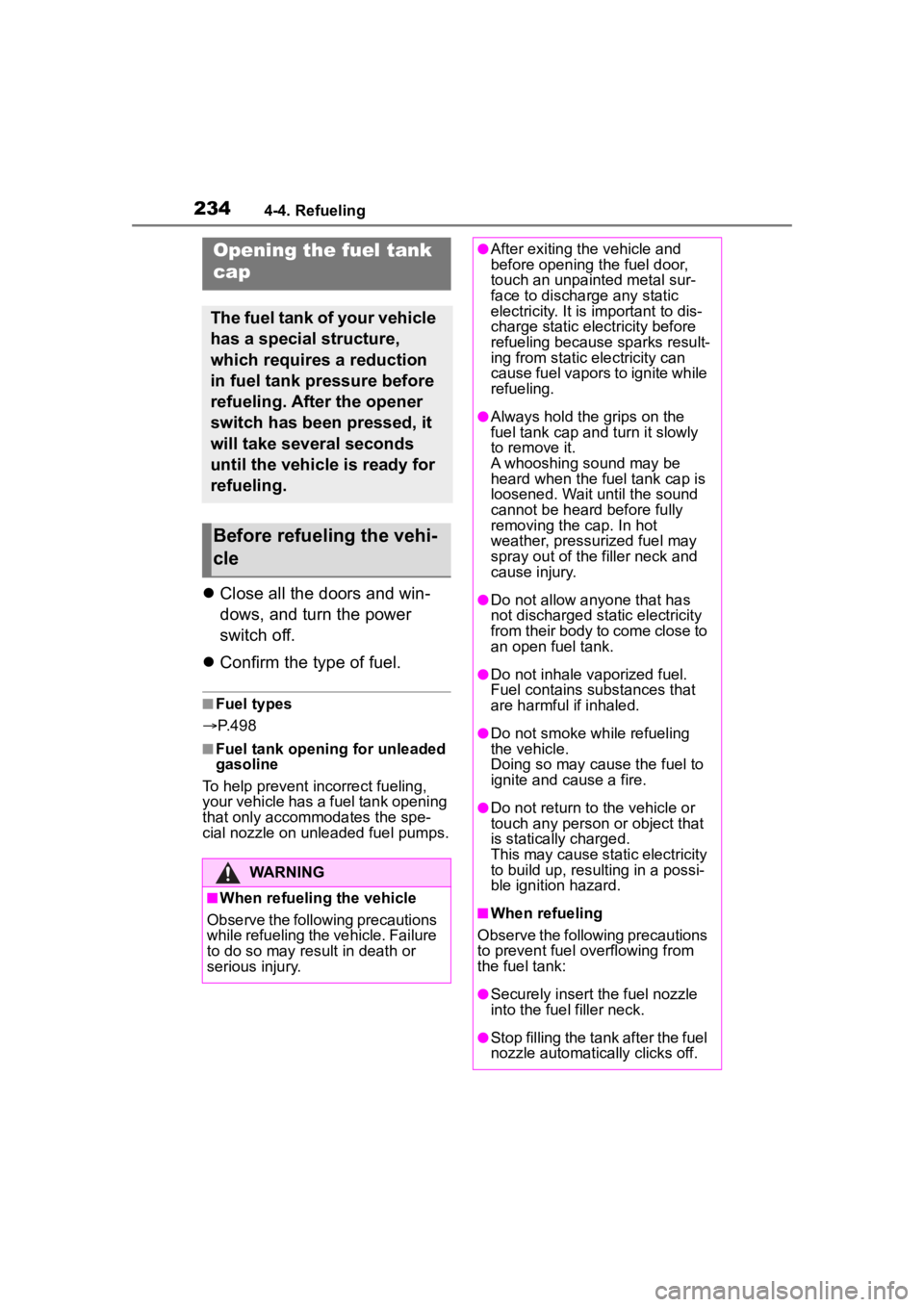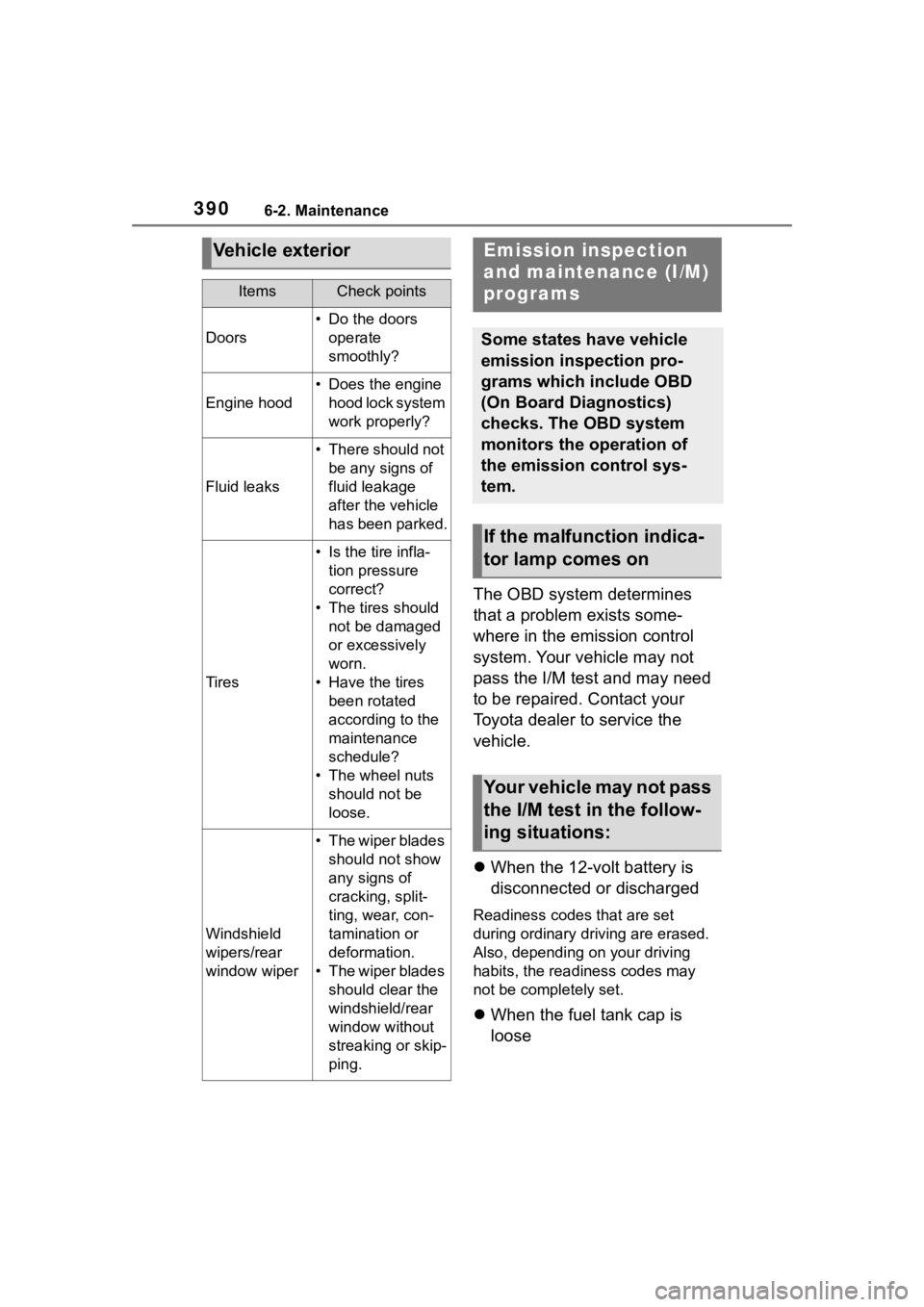fuel pressure TOYOTA HIGHLANDER HYBRID 2023 Owners Manual
[x] Cancel search | Manufacturer: TOYOTA, Model Year: 2023, Model line: HIGHLANDER HYBRID, Model: TOYOTA HIGHLANDER HYBRID 2023Pages: 572, PDF Size: 14.07 MB
Page 1 of 572

1
2
3
4
5
6
7
8
9
9
HIGHLANDER HEV_U
Pictorial indexSearch by illustration
For safety
and securityMake sure to read through them
(Main topics: Child seat, theft deterrent system)
Vehicle status
information and
indicatorsReading driving-related information
(Main topics: Meters, multi-information display)
Before driving
Opening and closing the doors and windows,
adjustment before driving
(Main topics: Keys, doors, seats)
Driving
Operations and advice which are necessary for
driving
(Main topics: Starting hybrid system, refueling)
Interior featuresUsage of the interior features
(Main topics: Air conditioner, storage features)
Maintenance
and careCaring for your vehicle and maintenance
procedures
(Main topics: Interior and exterior, light bulbs)
When trouble
arisesWhat to do in case of malfunction and emergency
(Main topics: 12-volt battery discharge, flat tire)
Vehicle
specificationsVehicle specifications, customizable features
(Main topics: Fuel, oil, tire inflation pressure)
For ownersReporting safety defects for U.S. owners, and seat
belt, SRS airbag and headlight aim instructions for
Canadian owners
IndexSearch by symptom
Search alphabetically
Page 4 of 572

4TABLE OF CONTENTS
Positioning a floor jack .......395
Engine compartment .......... 396
12-volt battery .................... 402
Tires ................................... 404
Tire inflation pressure......... 415
Wheels ............................... 417
Air conditioning filter ........... 418
Cleaning the hybrid battery (trac- tion battery) air intake vents......................................... 420
Electronic key battery ......... 423
Checking and replacing fuses ......................................... 425
Headlight aim ..................... 427
Light bulbs .......................... 428
7-1. Essential information Emergency flashers ........... 438
If your vehicle has to be stopped in an emergency .............. 438
If the vehicle is submerged or water on the road is rising
......................................... 439
7-2. Steps to take in an emergency If your vehicle needs to be towed......................................... 441
If you think something is wrong ......................................... 443
If a warning light turns on or a warning buzzer sounds .... 445
If a warning message is dis- played .............................. 456
If you have a flat tire ........... 461
If the hybrid system will not start ......................................... 474
If you lose your keys .......... 475
If the fuel filler door cannot be opened ............................. 476
If the electronic key does not operate properly ............... 477If the 12-volt battery is dis-
charged ............................ 479
If your vehicle overheats .... 484
If the vehicle becomes stuck ......................................... 488
8-1. Specifications Maintenance data (fuel, oil level, etc.) .................................. 490
Fuel information ................. 498
Tire information .................. 500
8-2. Customization Customizable features ....... 510
8-3. Initialization Items to initialize ................ 523
9-1. For owners Reporting safety defects for U.S. owners ............................. 526
Reporting safety defects for Canadian owners ............. 526
Seat belt instructions for Cana- dian owners (in French) ... 527
SRS airbag instructions for Canadian owners (in French)
......................................... 528
Headlight aim instructions for Canadian owners (in French)......................................... 53
5
What to
do if... (Troubleshooting)
......................................... 538
Alphabetical Index.............. 541
7When trouble arises
8Vehicle specifications
9For owners
Index
Page 13 of 572

13Pictorial index
Precautions for winter season.............................................. P.320
To prevent freezing (windshiel d wiper de-icer) ..................... P.330
Precautions for car wash
*.................................................... P.381
Fuel filler door ............................................... ..................... P.234
Refueling method ............................................... .................. P.234
Fuel type/fuel tan k capacity ................................... .............. P.491
Tires.......................................................... ........................... P.404
Tire size/inflation pressure ................................... ........ P.404, 495
Winter tires/tire chains ....................................... .................. P.320
Checking/rotation/tire pressur e warning system ..................P.404
Coping with flat tires......................................... .................... P.461
Hood ........................................................... ......................... P.394
Opening ............................................................................... P.394
Engine oil ..................................................... ........................ P.492
Coping with overheating ...................................................... P.484
Warning messages ............................................... ............... P.456
Front turn signal lights/parking lights
*..................... P.216,223
Parking lights
*............................................................... ..... P.223
Headlights/daytime running lights
*.................................. P.223
Headlights..................................................... ...................... P.223
Daytime running lights .. .................................................... P.223
Front side marker lights ....................................... ............. P.223
Parking lights
*/daytime running lights*........................... P.223
Front fog lights ............................................... .................... P.229
Stop/tail lights ............................................... ..................... P.223
Tail lights.................................................... ......................... P.223
Back-up lights
Shifting the shift lever to R ................................................... P.213
Light bulbs of the exterior lights for driving
(Replacing method: P.428, Watts: P.496)
Page 83 of 572

832-1. Instrument cluster
2
Vehicle status information and indicators
12.3-inch display
The units used on the meters and some indicators may differ
depending on the target region.
Warning lights inform the driver
of malfunctions in the indicated
vehicle’s systems.
Warning lights
(U.S.A.)
Brake system warning
light
*1 ( P.445)
(red)
(Canada)
Brake system warning
light
*1 ( P.445)
(yellow)
Brake system warning
light
*1 ( P.445)
High coolant temperature
warning light
*2 ( P.445)
Hybrid system overheat
warning light
*2 ( P.446)
Charging system warning
light
*2 ( P.446)
Low engine oil pressure
warning light
*2 ( P.446)
(U.S.A.)
Malfunction indicator
lamp
*1 ( P.446)
(Canada)
Malfunction indicator
lamp
*1 ( P.446)
SRS warning light
*1
( P.447)
(U.S.A.)
ABS warning light*1
( P.447)
(Canada)
ABS warning light*1
( P.447)
Inappropriate pedal opera-
tion warning light
*2
( P.447)
(red/yel-
low)
Electric power steering
system warning light
( P.448)
Low fuel leve l warning
light
*1( P.448)
Page 104 of 572

1042-1. Instrument cluster
“TPWS” (Tire Pressure Warn-
ing System) ( P.407)
• “Set Pressure” (tire pressure
warning system initialization)
Select to initialize the tire pressure
warning system.
• “Change Wheel” (register tire pressure warning system sensor
ID codes)
Select to register the ID codes of
the tire pressure s ensors to the tire
pressure warning system.
“Rear Seat Reminder”
( P.129)
Select to enable/disable the rear
seat reminder.
“Scheduled Maintenance”
( P.387)
Select to reset the scheduled main-
tenance information (maintenance
required message and distance
until maintenance necessary) after
all maintenance is performed.
■ Meter settings
Press and hold to change
the settings of the following
items:
Language
Select to change the language dis-
played.
Units
Select to change the units of mea-
sure displayed.
EV indicator ( P.211)
Select to enable/disable the EV
indicator.
Speedometer display (digital
speed)
Select to enable/disable the speed-
ometer display.
Gadget content
Select to turn the display of a gad-
get.
Fuel economy type
Select to change the average fuel
consumption display and an item to
be displayed as gadget.
Pop-up display
Select to enable/disable pop-up
displays for each relevant system.
Multi-information display off
Displays a blank screen.
Default setting
Select to reset the meter display
settings to the default setting.
■Vehicle functions and set-
tings that can be changed
P.510
Page 109 of 572

1092-1. Instrument cluster
2
Vehicle status information and indicators
ance/Eco score
Driving support system infor-
mation display
Audio system-linked display
Drive information
Drive information of Trip A/B
Energy monitor ( P.119)
Tire Pressure ( P.407)
AWD Control (if equipped)
Changing items to be displayed
on the side multi-information
displays. ( P.109)
■Changing contents in a
page
P. 1 0 7
■Changing contents to be
displayed on the side
multi-information displays
1 Press the or meter
control switch to select a
page.
2 To enable page edit, press
and hold the meter con-
trol switch.
3 Press the or meter
control switch to select the
desired side multi-information
display to be changed.
4 Press the or meter
control switch for the side
that is displayed to move
to a content list screen that
enables to select display/not
display each items. 5
Press or control
switch to select a content and
select to set for dis-
play/not display the item.
■Fuel economy
Use the displayed values as a ref-
erence only.
Current fuel consumption
Displays instantaneous current fuel
consumption.
Average fuel economy
The average fuel economy dis-
play can be changed in .
( P.108)
Average fuel economy (after
start)
Displays the average fuel con-
sumption since hybrid system start.
Average fuel economy (after
reset)
Displays average fuel consumption
since display was reset.
To reset the average fuel economy
display, press and hold the
meter control switch.
Page 234 of 572

2344-4. Refueling
4-4.Refueling
Close all the doors and win-
dows, and turn the power
switch off.
Confirm the type of fuel.
■Fuel types
P. 4 9 8
■Fuel tank opening for unleaded
gasoline
To help prevent incorrect fueling,
your vehicle has a fuel tank opening
that only accommodates the spe-
cial nozzle on unle aded fuel pumps.
Opening the fuel tank
cap
The fuel tank of your vehicle
has a special structure,
which requires a reduction
in fuel tank pressure before
refueling. After the opener
switch has been pressed, it
will take several seconds
until the vehicle is ready for
refueling.
Before refueling the vehi-
cle
WARNING
■When refueling the vehicle
Observe the following precautions
while refueling the vehicle. Failure
to do so may result in death or
serious injury.
●After exiting the vehicle and
before opening the fuel door,
touch an unpainted metal sur-
face to discharge any static
electricity. It is important to dis-
charge static electricity before
refueling because sparks result-
ing from static electricity can
cause fuel vapors to ignite while
refueling.
●Always hold the grips on the
fuel tank cap and turn it slowly
to remove it.
A whooshing sound may be
heard when the f uel tank cap is
loosened. Wait until the sound
cannot be heard before fully
removing the cap. In hot
weather, pressurized fuel may
spray out of the filler neck and
cause injury.
●Do not allow anyone that has
not discharged static electricity
from their body to come close to
an open fuel tank.
●Do not inhale vaporized fuel.
Fuel contains substances that
are harmful if inhaled.
●Do not smoke while refueling
the vehicle.
Doing so may cause the fuel to
ignite and cause a fire.
●Do not return to the vehicle or
touch any person or object that
is statically charged.
This may cause static electricity
to build up, resulting in a possi-
ble ignition hazard.
■When refueling
Observe the following precautions
to prevent fuel overflowing from
the fuel tank:
●Securely insert the fuel nozzle
into the fuel filler neck.
●Stop filling the tank after the fuel
nozzle automatically clicks off.
Page 319 of 572

3194-6. Driving tips
4
Driving
gently release the brake pedal
to allow the vehicle to move for-
ward slightly while avoiding
overuse of the accelerator
pedal. Doing so can help control
excessive gasoline consump-
tion.
Control and maintain the vehicle
at a constant speed. Before
stopping at a toll booth or simi-
lar, allow plenty of time to
release the accelerator and gen-
tly apply the brakes. A greater
amount of electrical energy can
be regenerated when slowing
down.
Use the air conditioning only
when necessary. Doing so can
help reduce excessive gasoline
consumption.
In summer: When the ambient
temperature is high, use the
recirculated air mode. Doing so
will help to reduce the burden on
the air conditioning system and
reduce fuel consumption as
well.
In winter: Because the gasoline
engine will not automatically cut
out until it and the interior of the
vehicle are warm, it will con-
sume fuel. Also, fuel consump-
tion can be improved by
avoiding overuse of the heater.Make sure to check the tire infla-
tion pressure frequently.
Improper tire inflation pressure
can cause poor fuel economy.
Also, as snow tires can cause
large amounts of friction, their
use on dry roads can lead to
poor fuel economy. Use tires
that are appropriate for the sea-
son.
Carrying heavy luggage will lead
to poor fuel economy. Avoid car-
rying unnecessary luggage.
Installing a large roof rack will
also cause poor fuel economy.
Since the gasoline engine starts
up and cuts out automatically
when cold, warming up the
engine is unnecessary. More-
over, frequently driving short
distances will cause the engine
to repeatedly warm up, which
can lead to excess fuel con-
sumption.
Highway driving
Air conditioning
Checking tire inflation
pressure
Luggage
Warming up before driv-
ing
Page 390 of 572

3906-2. Maintenance
The OBD system determines
that a problem exists some-
where in the emission control
system. Your vehicle may not
pass the I/M test and may need
to be repaired. Contact your
Toyota dealer to service the
vehicle.
When the 12-volt battery is
disconnected or discharged
Readiness codes that are set
during ordinary driving are erased.
Also, depending on your driving
habits, the readiness codes may
not be completely set.
When the fuel tank cap is
loose
Vehicle exterior
ItemsCheck points
Doors
• Do the doors
operate
smoothly?
Engine hood
• Does the engine hood lock system
work properly?
Fluid leaks
• There should not be any signs of
fluid leakage
after the vehicle
has been parked.
Tires
• Is the tire infla-tion pressure
correct?
• The tires should not be damaged
or excessively
worn.
• Have the tires been rotated
according to the
maintenance
schedule?
• The wheel nuts should not be
loose.
Windshield
wipers/rear
window wiper
• The wiper blades should not show
any signs of
cracking, split-
ting, wear, con-
tamination or
deformation.
• The wiper blades should clear the
windshield/rear
window without
streaking or skip-
ping.
Emission inspection
and maintenance (I/M)
programs
Some states have vehicle
emission inspection pro-
grams which include OBD
(On Board Diagnostics)
checks. The OBD system
monitors the operation of
the emission control sys-
tem.
If the malfunction indica-
tor lamp comes on
Your vehicle may not pass
the I/M test in the follow-
ing situations:
Page 393 of 572

3936-3. Do-it-yourself maintenance
6
Maintenance and care
Hybrid battery
(traction bat-
tery) air intake
vent (P.420)• Vacuum cleaner,
etc.
• Phillips screw- driver
Headlight aim
( P.427)• Phillips-head
screwdriver
Light bulbs
( P.428)
• Bulb with same
number and
wattage rating as
original
• Phillips-head screwdriver
• Flathead screw- driver
• Wrench
Radiator and
condenser
( P.400)
Tire inflation
pressure
( P.415)• Tire pressure
gauge
• Compressed air source
Washer fluid
( P.401)
• Water or washer
fluid containing
antifreeze (for
winter use)
• Funnel (used only for adding
water or washer
fluid)
WARNING
The engine compartment contains
many mechanisms and fluids that
may move suddenly, become hot,
or become electrically energized.
To avoid death or serious injury,
observe the following precautions.
ItemsParts and tools■When working on the engine
compartment
●Make sure that the “ACCES-
SORY” or “IGNITION ON” on
the multi-information display
and the “READY” indicator are
both off.
●Be careful not to touch the
engine, power control unit, radi-
ator, exhaust manifold, etc. right
after driving as they may be hot.
Oil and other fluids may also be
hot.
●Do not leave anything that may
burn easily, such as paper and
rags, in the engine compart-
ment.
●Do not smoke, cause sparks or
expose an open flame to fuel.
Fuel fumes are flammable.
■When working near the elec-
tric cooling fan or radiator
grille
Be sure the power switch is off.
With the power switch in ON, the
electric cooling fa n may automati-
cally start to run if the air condi-
tioning is on and/or the coolant
temperature is high. ( P.400)
■Safety glasses
Wear safety glasses to prevent
flying or falling material, fluid
spray, etc. from getting in your
eyes.
NOTICE
■If you remove the air cleaner
filter
Driving with the air cleaner filter
removed may cause excessive
engine wear due to dirt in the air.